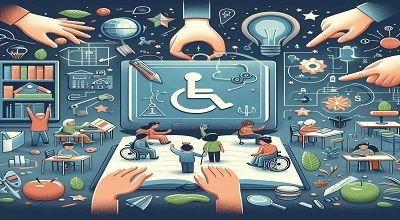Accessibility in Education
Accessibility in Education: Accessibility is a critical aspect of education that ensures all students, regardless of their abilities or disabilities, have equal access to learning opportunities. In this comprehensive blog post, we will explore the various dimensions of accessibility in education, including its importance, strategies for implementation, legal frameworks, and the role of technology.
Introduction to Accessibility
Accessibility in education refers to the design of educational environments, resources, and services that are usable by all students, including those with disabilities. It encompasses not only physical access to buildings but also access to learning materials, technology, and instructional practices. The goal of accessibility is to remove barriers to learning and to promote equity in educational outcomes.
The Importance of Accessibility in Education
Creating accessible educational environments is vital for several reasons:
- Equity: All students deserve the same opportunities to succeed.
- Diversity: A diverse student body enriches the learning experience for everyone.
- Legal Compliance: Institutions must comply with laws mandating accessibility.
- Social Responsibility: Educators have a moral obligation to support all learners.
Legal Frameworks Supporting Accessibility
The Americans with Disabilities Act (ADA)
The ADA is a landmark civil rights law that prohibits discrimination against individuals with disabilities. It ensures that schools provide accessible facilities and services to all students.
Section 504 of the Rehabilitation Act
Section 504 protects the rights of individuals with disabilities in programs and activities that receive federal funding. This includes public schools, which must provide accommodations for students with disabilities.
Individuals with Disabilities Education Act (IDEA)
IDEA ensures that students with disabilities receive a Free Appropriate Public Education (FAPE) tailored to their individual needs. It mandates the creation of Individualized Education Programs (IEPs) for eligible students.
Understanding Different Types of Disabilities
To effectively create accessible learning environments, it’s essential to understand the various types of disabilities that students may have.
Physical Disabilities
Physical disabilities can affect a student’s mobility and ability to navigate the school environment. Accommodations may include wheelchair ramps and accessible classrooms.
Sensory Disabilities
Sensory disabilities, including vision and hearing impairments, require specific accommodations, such as sign language interpreters or braille materials.
Learning Disabilities
Learning disabilities, such as dyslexia and ADHD, can affect a student’s ability to process information. Strategies for these students may include specialized instruction and technology supports.
Mental Health Disabilities
Mental health conditions can impact a student’s focus, motivation, and overall well-being. Support systems, including counseling services, are crucial for these students.
Strategies for Creating an Accessible Learning Environment
Physical Accessibility
To ensure physical accessibility, schools should:
- Install ramps and elevators.
- Ensure accessible restrooms.
- Design classrooms with flexible seating arrangements.
Digital Accessibility
Digital resources must be accessible to all students. This includes:
- Using accessible websites and platforms.
- Providing alternative formats for digital materials (e.g., audio, braille).
- Ensuring videos have captions and transcripts.
Curriculum Accessibility
Curriculum design should consider diverse learning needs by:
- Incorporating various teaching methods (visual, auditory, kinesthetic).
- Offering differentiated instruction and assessments.
- Providing additional resources and supports as needed.
The Role of Technology in Accessibility
Assistive Technology
Assistive technology includes devices and software designed to help students with disabilities. Examples include screen readers, speech-to-text software, and adaptive keyboards.
Universal Design for Learning (UDL)
UDL is an educational framework that promotes flexible approaches to teaching and learning. It encourages educators to provide multiple means of engagement, representation, and action.
Online Learning Platforms
With the rise of online education, ensuring these platforms are accessible is paramount. This involves:
- Regularly auditing digital content for accessibility.
- Training educators on best practices for online instruction.
- Incorporating feedback from students about their experiences.
Challenges in Achieving Accessibility
Despite the importance of accessibility, many challenges exist, including:
- Limited funding for necessary modifications.
- Lack of awareness or training among educators.
- Resistance to change from established practices.
Best Practices for Educators
Educators play a crucial role in fostering accessibility in the classroom. Best practices include:
- Continuous professional development on accessibility.
- Collaborating with special education professionals.
- Actively seeking student feedback on accessibility issues.
Case Studies: Successful Implementation of Accessibility
Many schools have successfully implemented accessibility initiatives. Case studies can highlight:
- Innovative programs that support students with disabilities.
- Partnerships with community organizations to enhance resources.
- Success stories of individual students overcoming barriers.
Conclusion
Accessibility in education is not just a legal requirement; it is a fundamental aspect of creating equitable learning environments. By understanding the importance of accessibility and implementing effective strategies, educators can ensure that all students have the opportunity to thrive.
FAQs
FAQ 1: What is accessibility in education?
Answer: Accessibility in education refers to the design of learning environments, resources, and services that are usable by all students, including those with disabilities.
FAQ 2: Why is accessibility important in schools?
Answer: Accessibility promotes equity, supports diverse learners, ensures legal compliance, and fulfills educators’ moral responsibilities to all students.
FAQ 3: What laws support accessibility in education?
Answer: Key laws include the Americans with Disabilities Act (ADA), Section 504 of the Rehabilitation Act, and the Individuals with Disabilities Education Act (IDEA).
FAQ 4: What types of disabilities should educators consider?
Answer: Educators should consider physical, sensory, learning, and mental health disabilities when creating accessible learning environments.
FAQ 5: How can technology support accessibility?
Answer: Technology can support accessibility through assistive devices, online learning platforms, and tools designed to enhance engagement and participation.
FAQ 6: What are some best practices for creating accessible classrooms?
Answer: Best practices include continuous professional development, collaboration with special education professionals, and actively seeking student feedback.
Summary
Creating a truly inclusive educational environment takes commitment and effort, but the benefits for all students are immeasurable. By prioritizing accessibility, educators can foster a more equitable and enriching learning experience.
